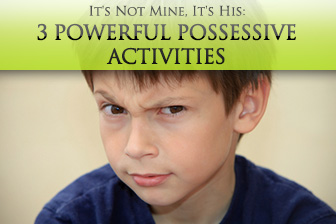
Possessives can be confusing for students, and unfortunately it is a topic that can be a bit dry.
Since students really need to master all forms of possessives, it is important to practice them often and with varied methods. Try out these three powerful possessive activities for lasting results.

Try These 3 Powerful Possessive Activities with Your Students
-
1
Meaningful Objects Description
This activity allows students to get to know each other better by giving them the chance to share some personal details. It is part guessing game and part show and tell with a twist. To organize the meaningful objects description exercise, ask students to bring in one object that has significant value to them that they would like to share with the class. Also tell them to keep it hidden and to save all the details for the lesson. Begin the activity by collecting their objects in a container so the rest of the class cannot observe who puts what inside.
The first part is a guessing game in which you will pull out objects, and ask students to name them. Then hand each student one of the objects randomly. Before you begin this part of the activity you may want to review possessives and also provide the question formats you would like them to use. They will then do a mingling activity, going around the room asking each student a question about the object they have in hand. The question possibilities could be: Is this book yours or Is this your book? Yes it is my book/No it isn't my book. When students have found the owner of the object, they give the object to the owner and then continue mingling until everyone has their object back. Rules of the game you want to point out are as follows: You must wait until someone asks you a question to claim your object, and once you have found both the object you own and you have found the owner of the object you were given, you may sit down.
Once everyone is seated, the next part of the activity begins. Students will describe their object to the class in one minute. You may want to provide a challenge to each presenter. Give them a list of questions or points they should try to cover in their minute. The class pays attention to see how many of the given questions each person answers. Here are some possible questions:
- What is the object?
- Who does it belong to or who owns the object?
- Who gave it to you or where did you get it?
- How long have you had it?
- What do you use it for or What is it's purpose?
- Describe the object—size, shape, color
- Use at least six possessives in your description
- What is important or significant about your object?
To wrap up the activity, and ensure good listening, allow the students to debrief about the objects and have a short discussion.
-
2
Who Lives in My House?
This activity incorporates a lot of vocabulary practice, and is also a memory game. It has three parts. The first part requires students to write down three to five sentences describing their homes.
An example could be: My family lives in a house/apartment/condo. My (Our) house has three bedrooms. My house has one bathroom and a large kitchen.The second part is a family description of their home in one to two sentences.
For example: My mom and dad have the big bedroom, I have my own room and my brother shares a room with my baby sister.Lastly, students go in rounds and read one of their sentences to the group. The next person describes what the first person said, and then they add a sentence to the round. Each student then does the same thing trying to remember one detail of every student in order. This can go around until the sentences are exhausted, and the students need help remembering. It looks like this.
Student 1 (Molly): My house has two bedrooms.
Student 2 (Jamie): Molly's house has two bedrooms, but mine doesn't. My house has four bedrooms.
Student 3 (Greg): Molly's house has two bedrooms, Jamie's house has four bedrooms and my house has two bedrooms too.This activity takes some set-up, but if you have played any memory games before the instructions should fall into place. As always, provide good examples and remind students how to practice possessives.
-
3
Goofy Cards
Make a set of cards of nouns and verbs. Divide the class into two teams. Each team should have a stack of cards. Taking team turns, one student at a time draws two cards. To get a point, they must generate a grammatically correct sentence using either possessive pronouns or student names. Example cards could be:
Spider Travel Carrot Exam Drink Flower Travel Dance Exam England A student on team one draws two cards—Travel and Carrot. The student must make a correct sentence using any tense and with possessives.
Answer: The carrot's dream was to travel the world. The team gets a point. If you want the activity to be even more nonsensical, you could require each team to devise a story sentence by sentence. Each time they draw cards the student would continue adding detail to the story.
Practicing possessives in any form can be enjoyable and effective. The above activities are perfect for recycling and modifying as you go.
Make these activities your own, and enable your students with the power of possessives!
P.S. If you enjoyed this article, please help spread it by clicking one of those sharing buttons below. And if you are interested in more, you should follow our Facebook page where we share more about creative, non-boring ways to teach English.







